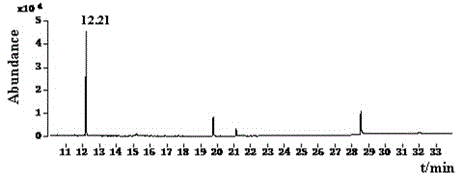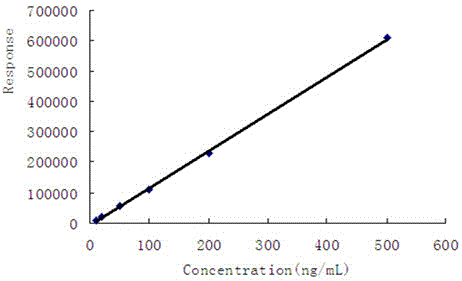Method for determining silthiofam residues in fruits and vegetables by GC-EI-MS (gas chromatography-mass spectrometry with electron impact ionization)
A GC-EI-MS and silthiocarb technology, which is applied in the field of silthiocarb residues, can solve the problems of high price and relatively long system consumption, and achieve the effects of simple operation, avoiding matrix interference, and ensuring people's food safety
- Summary
- Abstract
- Description
- Claims
- Application Information
AI Technical Summary
Problems solved by technology
Method used
Image
Examples
Embodiment 1
[0034]Embodiment 1: detection of silthiocarb residues in apples
[0035] (1) Sample pretreatment
[0036] Weigh 10.0 g of well-mixed apples into a 50 mL centrifuge tube, accurately add 20 mL of acetonitrile, homogeneously extract for 1 min, add 3 g of anhydrous magnesium sulfate and 2 g of sodium chloride, vortex for 1 min, and centrifuge at 7000 r / min for 5 min. After centrifugation, take 6mL of acetonitrile extract and transfer to a solution containing 900mg anhydrous magnesium sulfate, 300mgC 18 and 150mgPSA in a centrifuge tube, vortex for 1min, and centrifuge at 5000r / min for 5min. Take 4 mL of the supernatant in a nitrogen blowpipe, dry it with nitrogen at 40°C, add acetone / n-hexane mixed solvent with a volume ratio of 1 / 1 to dissolve the residue, vortex and mix evenly, pass through the membrane, and transfer it to the sample bottle for GC- EI-MS determination.
[0037] (2) Preparation of standard working solution
[0038] Accurately weigh 25±0.1mg of the standard pr...
Embodiment 2
[0063] Example 2: Detection of Silthiocarb Residues in Cucumber
[0064] (1) Sample pretreatment
[0065] Weigh 10.0 g of well-mixed cucumber into a 50 mL centrifuge tube, accurately add 20 mL of acetonitrile solution containing 1% acetic acid, extract homogeneously for 1 min, add 3 g of anhydrous magnesium sulfate, 2 g of sodium acetate and 2 mL of water, vortex for 1 min, Centrifuge at 7000r / min for 5min. After centrifugation, take 6mL of acetonitrile extract and transfer to a solution containing 900mg anhydrous magnesium sulfate, 300mgC 18 and 150mgPSA in a centrifuge tube, vortex for 1min, and centrifuge at 5000r / min for 5min. Take 4mL of the supernatant in a nitrogen blowpipe, dry it with nitrogen at 40°C, add acetone / n-hexane mixed solvent with a volume ratio of 1 / 1 to dissolve the residue, vortex and mix well, then transfer it to an injection bottle for GC-EI - MS determination.
[0066] (2) Preparation of standard working solution
[0067] Dilute the 1000 μg / mL st...
PUM
| Property | Measurement | Unit |
|---|---|---|
| length | aaaaa | aaaaa |
| thickness | aaaaa | aaaaa |
| melting point | aaaaa | aaaaa |
Abstract
Description
Claims
Application Information
 Login to View More
Login to View More - R&D
- Intellectual Property
- Life Sciences
- Materials
- Tech Scout
- Unparalleled Data Quality
- Higher Quality Content
- 60% Fewer Hallucinations
Browse by: Latest US Patents, China's latest patents, Technical Efficacy Thesaurus, Application Domain, Technology Topic, Popular Technical Reports.
© 2025 PatSnap. All rights reserved.Legal|Privacy policy|Modern Slavery Act Transparency Statement|Sitemap|About US| Contact US: help@patsnap.com



